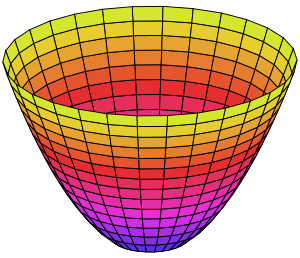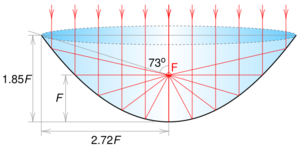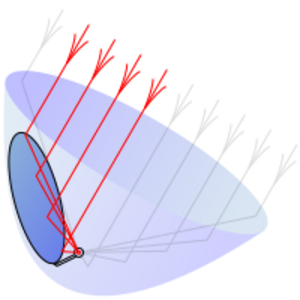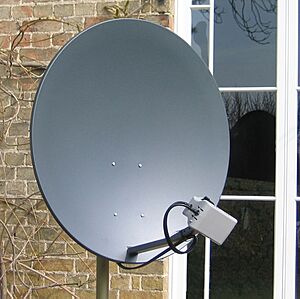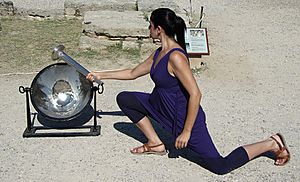Parabolic reflector facts for kids

A parabolic reflector is a special kind of shiny surface shaped like a dish. It's used to gather or send out different types of energy, like light, sound, or radio waves. Imagine a parabola (a U-shaped curve) spinning around its center line; the 3D shape it creates is called a paraboloid, and that's the shape of these reflectors.
This unique shape helps the reflector do two main things:
- It can take energy coming in as straight, parallel lines (like sunlight) and focus it all to a single point, called the "focus."
- Or, if you put an energy source at that focus point, the reflector can bounce the energy back out in a strong, straight beam.
Parabolic reflectors are super useful! They help us collect energy from far away, like gathering light from distant stars with reflecting telescopes, or picking up quiet sounds with parabolic microphones. They also help us send out strong beams of energy, like the light from flashlights and car headlights, or radio waves from satellite dishes for communication.
Contents
How Parabolic Reflectors Work
The 3D shape of these reflectors is actually called a paraboloid. A parabola is just the 2D curve. Think of it like the difference between a ball (sphere) and a flat circle. Even though we often say "parabolic," the real shape is a paraboloid.
The amazing thing about a paraboloid is its special geometric property:
- Any ray of energy that hits the dish while traveling parallel to its central axis will bounce off and go straight to the "focus" point.
- And if energy starts at the focus point and hits the dish, it will bounce off and travel outward in a perfectly straight, parallel beam.
This is why parabolic reflectors are so good at concentrating energy or sending it out in a focused way. Unlike round (spherical) mirrors, which can sometimes blur the image, parabolic reflectors can focus energy very precisely, no matter how wide the incoming beam is. However, if the energy doesn't come in perfectly straight or the source isn't exactly at the focus, the image might get a little distorted. This is called "coma" and is mostly a concern for very precise tools like telescopes.
How Accurate Do They Need to Be?
How perfectly shaped a parabolic dish needs to be depends on the type of energy it's working with. If the dish is off by even a tiny bit, the reflected energy can get messed up. To work well, the dish usually needs to be accurate to about 1/20th of the energy's wavelength.
- For visible light, which has very tiny wavelengths (around 400 to 700 nanometers), a reflector needs to be incredibly precise – accurate to about 20 nanometers! To give you an idea, a human hair is about 50,000 nanometers thick, so the accuracy needed is much, much smaller than a hair. For example, the famous Hubble Space Telescope mirror had a tiny flaw (it was off by about 2,200 nanometers at its edge), which caused blurry images until it was fixed.
- For microwaves, like those used for satellite TV, the wavelengths are much longer (around ten millimeters). This means the dishes don't need to be quite as perfect; they can be off by about half a millimeter and still work well.
Different Kinds of Parabolic Reflectors
Focus-Balanced Reflectors
Sometimes, it's helpful if the center of gravity of the reflector dish is exactly at its focus point. This design is called a "focus-balanced" reflector. It makes it easy to turn the dish to follow a moving energy source, like the Sun, while the focus point (where you collect the energy) stays still. This is useful for things like solar ovens that need to track the sun's movement.
Scheffler Reflectors
The Scheffler reflector is another interesting type. It's designed so that the focus point is actually outside the dish. To keep the focus steady as the dish moves, this reflector is made to be flexible. It bends slightly as it rotates, which helps keep the energy focused in the right spot. Scheffler reflectors aren't super precise, but they work great for things like solar cooking, where you just need to heat a pot, not focus light to an exact pinpoint.
Off-Axis Reflectors
A paraboloid shape can actually be huge, but practical reflectors only use a part of it. Often, the part used includes the very bottom (the "vertex") of the dish, where the curve is strongest. However, if you put a receiver at the focus of such a dish, the receiver itself can block some of the incoming energy, casting a shadow on the reflector.
To avoid this, some reflectors are made from a section of the paraboloid that is off-center from the vertex and the main axis. This means the receiver doesn't block any of the dish, allowing the whole reflector to gather energy. You often see this design in satellite dishes for TV and in some large astronomical telescopes, like the James Webb Space Telescope.
History of Parabolic Reflectors
People have known about the idea of parabolic reflectors for a very long time! The ancient Greek mathematician Diocles described them in his book On Burning Mirrors and showed how they could focus parallel light to a single point.
There's a famous story that Archimedes used giant parabolic mirrors to set Roman ships on fire during the Siege of Syracuse around 212 BCE. While it's a cool story, it probably isn't true, as it wasn't mentioned by writers at the time.
Later, in the 13th century, the physicist Roger Bacon also studied parabolic mirrors. In 1663, James Gregory suggested using parabolic mirrors in reflecting telescopes to get clearer images, but he couldn't find anyone skilled enough to build one. Even Isaac Newton knew about them but chose a simpler spherical mirror for his telescope.
Before electric lights, Lighthouses used parabolic mirrors to create strong beams of light from lanterns. In 1888, the German physicist Heinrich Hertz built the very first parabolic reflector antenna, which was a big step for radio technology.
Modern Uses of Parabolic Reflectors
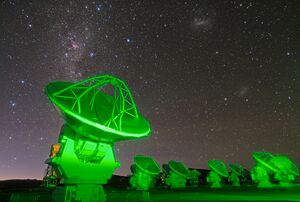
Today, parabolic reflectors are everywhere! Some of their most common uses include:
- Satellite dishes: For receiving TV signals or sending data.
- Telescopes: Both reflecting telescopes (for visible light) and radio telescopes (for radio waves) use them to gather faint signals from space.
- Parabolic microphones: Used to pick up sounds from far away, like bird calls or conversations.
- Solar cookers and furnaces: To concentrate sunlight for cooking or generating heat.
- Lighting: In spotlights, car headlights, and other lamps to create strong, focused beams.
You might have seen them used to light the Olympic Flame! Traditionally, the flame is lit in Greece using a parabolic reflector that focuses sunlight to ignite the torch.
Parabolic reflectors can even create cool optical illusions. These illusions often use two opposing parabolic mirrors to make an object placed on the bottom mirror appear to float in the air above the top mirror!
Another interesting use is in liquid-mirror telescopes. These telescopes use a rotating dish of liquid mercury to form a perfect parabolic shape, which acts as a giant mirror.
Finally, simple parabolic reflectors can be used to boost wireless signal strength for things like Wi-Fi, helping signals travel further and stronger.
See also
- John D. Kraus
- Liquid-mirror telescope, paraboloids produced by rotation
- Parabolic antenna
- Parabolic trough
- Solar furnace
- Toroidal reflector


